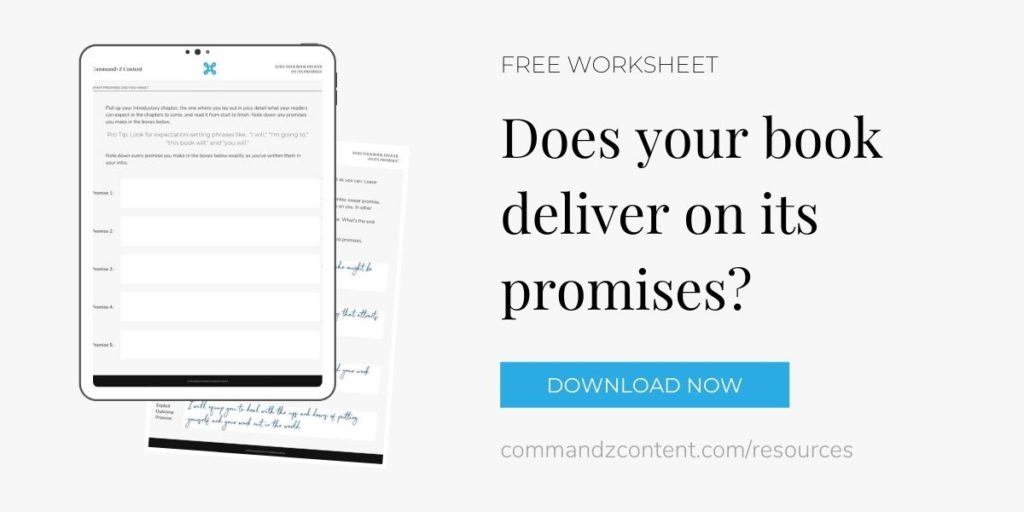Assessing your manuscript objectively is hard—that’s why people hire me to help—but there is one essential question you should ask yourself if you want to make sure your reader doesn’t finish your book wondering, wait… that’s IT??
Did I fulfill my promise to my reader?
Or, in other words, did I do/teach/prove what I said I would in the introduction?
Because if you tell your reader:
“I will teach you how to ________,” or
“This book will show you ________,” or
“You will ________”
You better make damn sure you do that thing.
Where Dreams are Born and Expectations Get Set Harder Than Concrete: Your Book’s Introduction
A book’s introduction exists to tell your reader what your book is about—groundbreaking insight, I know. But it has several important jobs: it tells your reader why the book exists, who you are and why they should listen to you. And then there’s the job we’ll be talking about here. Your introduction is where you lay out in juicy detail what your book will do for your reader and set their expectations for what’s to come.
Let’s take a look at a few examples.
Austin Kleon maps out what lies ahead in Show Your Work! 10 Ways to Share Your Creativity and Get Discovered (page 3)
“I’m going to try to teach you how to think about your work as a never-ending process, how to share your process in a way that attracts people who might be interested in what you do, and how to deal with the ups and downs of putting yourself and your work out in the world.”
David McRaney sets your expectations while also making you wonder, “oh god what will this mean about meee” in You Are Not So Smart (page xvi)
“With each new subject in these pages you will start to see yourself in a new way. You will soon realize you are not so smart, and thanks to a plethora of cognitive biases, faulty heuristics, and common fallacies of thought, you are probably deluding yourself minute by minute just to cope with reality. Don’t fret. This will be fun.”
Carol Dweck sets a high bar in the opening pages of her bestselling (updated) Mindset: The New Psychology of Success:
“In this book, you’ll learn how a simple belief about yourself—a belief we discovered in our research—guides a large part of your life.”
“No book has ever explained this mindset and shown people how to make use of it in their lives. You’ll suddenly understand the greats—in the sciences and arts, in sports, and in business—and the would-have-beens. You’ll understand your mate, your boss, your friends, your kids. You’ll see how to unleash your potential—and your children’s.”
“I’ve filled each chapter with stories both ripped from the headlines and based on my own life and experience, so you can see the mindsets in action.”“At the end of each chapter and throughout the last chapter, I show you ways to apply the lessons—ways to recognize the mindset that is guiding your life, to understand how it works, and to change it if you wish.”
These aren’t just value propositions; they’re promises. And if Carol Dweck had made these promises and then written a memoir about her years in medical school instead, Mindset would be lining birdcages instead of changing lives.

As an author, you have to abide by one of the simplest rules we live by as citizens in a mostly-functioning society: If I tell you that I’m going to do something, then I need to do that thing. Otherwise, I have broken my promise to you. Broken promises will undermine your readers’ trust in you—and rightfully so, given that you didn’t deliver the value you told them you would.
So does your book fulfill the promises you set out in your introduction? Does it do for your reader what you say it will? And is it clear enough that your reader knows that you’ve made good on your promise? These are questions I ask when assessing every manuscript, and so should you.
It sounds so simple, right? Even obvious. And yet it is one of the fundamental things that gets lost when you’ve been neck-deep in the book-writing weeds—and there’s an excellent reason why. Your ideas change as you write, and it’s a normal part of the process.
As you do the work of clarifying your message, refining your argument, and communicating your ideas, you may find that they shift or even evolve without your noticing. It’s entirely possible that the book you ended up writing is not the book that you sat down thinking you were going to write. (And a lot of times that’s a good thing!) So you need to be honest when you answer this question: Did you deliver on your promises?
“Of course, I did,” you might be thinking. But will your reader think the same thing? How can you be sure?
What promises did you make?
No, really. Write them out.
You can download the worksheet I created specifically for this exercise, or just open up a Google doc or take out a sheet of paper and write out a 1, 2, 3.
Then open up your manuscript and read your book’s introduction. When you see that you’ve made a promise, write it down.
I’ll make Austin Kleon our example. Take another look at the excerpt from his introduction to Show Your Work!
“I’m going to try to teach you how to think about your work as a never-ending process, how to share your process in a way that attracts people who might be interested in what you do, and how to deal with the ups and downs of putting yourself and your work out in the world.”
Now, let’s tweak the language to make your promise as clear and direct as you can. Leave little room for doubt. I want you to…
- BE EXPLICIT: Speak directly and in full sentences. Write it like a true pinkie-swear promise.
- TAKE OWNERSHIP: If necessary, reframe the statement to put the onus on you. In other words, turn “you’ll see” to “I’ll show you.”
- AIM FOR THE OUTCOME: Set aside the process and jet-pack to the outcome. What’s the end result? Write that.
Let’s go back to our Austin Kleon examples and run them through this :
I will teach you how to think about your work as a never-ending process.
I will show you how to share your process in a way that attracts people who might be interested in what you do.
I will equip you to deal with the ups and downs of putting yourself and your work out in the world.
Once you have your promises listed out, the question is: did you hold up your end of the deal?
Where do you deliver?
Now it’s time to read.
Using your notes doc as a reference, go promise by promise and find the specific parts in your manuscript where you do/teach what you said you would. I am talking down to the chapter, section, or even the page number(s) where you deliver on your promises. Write them down next to each promise on your list: where specifically do you fulfill that promise to your reader? And heads up: if you can’t find it, it probably means you didn’t do it.
You may be tempted to just skip straight to the chapter where you’re pretty sure you talk about the stuff you promised, but I encourage you to read the whole thing. There may be tidbits you totally forgot about tucked away in chapter five.
Let’s see if Show Your Work! delivered on its promise to show you how to share your process in a way that attracts people who might be interested in what you do.
OH, it’s also worth noting that I’m looking specifically for how-to’s, because that’s what Kleon told me to expect when he said I’ll show you HOW TO share your process. So I’m fixing my hawk-eyed gaze on implementable ideas, action items, creative suggestions, and even anecdotal examples that show how someone else shares their process.

I find what I’m looking for in Chapter two, “Think Process, Not Product.”
Kleon begins by explaining an essential idea: audiences love getting a glimpse behind the curtain because “humans are interested in other human beings and what other human beings do.” And he makes a case for his suggested approach, explaining how it builds trust, teaches, and lets your audience connect with you and your product or service. With that foundation of understanding in place, he can then move into the (promised) how-tos.
- “Become a documentarian of what you do. Start a work journal: Write your thoughts down in a notebook, or speak them into an audio recorder. Keep a scrapbook…” (pp. 41–43)
- “Once a day, after you’ve done your day’s work, go back to your documentation and find one little piece of your process that you can share.” (p. 48)
- “Where do you get your inspiration? What sorts of things do you fill your head with? What do you read? … Your influences are all worth sharing because they clue people in to who you are and what you do—sometimes even more than your work.” (pp. 76–77)
I could keep going, but I think you get the point. Kleon delivers lots of actionable ideas for how to share your process. He delivered on his promise.
As you assess your work, try to stay as objective as you can. It’s easy to rationalize that you’ve hit the mark because you know what you intended to say. That’s why there’s one more question that you need to ask yourself.
Does your reader know you delivered?
Our brains will fill in the gaps and overlook mistakes because we know what we were trying to write. It’s one of the reasons why reading your writing out loud is such an effective way to catch mistakes and clunky writing. Sure, you know what you were trying to communicate in these pieces, but did you say it so that your reader can understand “Hey, you know that thing I said I would teach you? Well, I’m teaching it to you right now”?
So, assess your clarity. Do you talk around the subject, or do you lovingly bonk the reader over the head with it?
If you can point to the specific instance(s) where you’ve delivered on a promise with “I straight-up said it” clarity, then you’re good to go.
If you can point to the specific instance(s) where you’ve implied the answer but haven’t said it directly, then look for organic opportunities to make the purpose of what you’re doing/teaching clearer.
If you can’t find the specific instance where you’ve delivered on a promise, you need to start writing.

[…] they’re hunting down those major issues that could derail your whole message, rooting out broken promises like a truffle pig. They’re working and reworking your structure, sliding your book’s […]
[…] need to see the thread linking the stuff about YOU to the stuff about THEM, aka the promises you’ve made in your book. Share only what’s relevant and enriching to the read. That story about Aunt Bea’s lemon […]
[…] I’ve written about this at length, but it bears repeating: Broken promises will undermine your readers’ trust in you. If you state in your introduction that you’re going to teach them [X], then you better make sure your reader can [joyfully X] by the time they reach the conclusion. […]